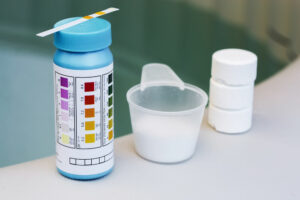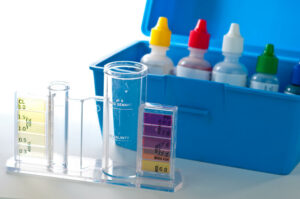Understanding Pool Shock
Pool shock, also known as super chlorination, is a method used to kill bacteria, algae, and other organic contaminants in the water. This process involves the addition of an excess amount of chlorine (or other sanitizer) to the pool water to swiftly raise the sanitizer level. This rapid increase in sanitizer is often the only way to deal with certain problems, like a severe algae outbreak or the aftermath of heavy pool use. It’s an important part of regular pool maintenance and contributes significantly to ensuring the health and clarity of your pool water.
Types of Pool Shock: Chlorine and Non-Chlorine
There are two primary types of pool shock products on the market: chlorine-based and non-chlorine based. Chlorine-based shocks are the most common and contain a high concentration of chlorine that rapidly kills bacteria and algae. Non-chlorine shocks, on the other hand, use a potassium monopersulfate compound that oxidizes contaminants in the pool. Non-chlorine shocks are beneficial because they allow for swimming to resume shortly after treatment, but they do not kill algae.
The Chemistry of Pool Shocking
The chemistry behind pool shocking is complex but can be simplified as the breakdown and removal of organic waste in the water. When chlorine or a non-chlorine shock is added to pool water, it works by oxidizing the molecules in the contaminants. This chemical reaction breaks the contaminants apart and allows the filter system to remove them from the water. In the case of chlorine shock, free chlorine is created, which is the active sanitizer in pool water.

Benefits of Shocking Your Swimming Pool
Shock treatments are beneficial for several reasons. They help to kill bacteria, viruses, and algae, ensuring the health and safety of those who use the pool. They also oxidize and remove organic waste, improving the clarity and overall appearance of the water. Shocking can eliminate chloramines, which cause the ‘chlorine’ smell often associated with swimming pools and can lead to skin and eye irritation. Regular shocking is an integral part of maintaining balanced water chemistry.
The Role of Pool Shock in Killing Bacteria and Algae
One of the primary roles of pool shock is to kill bacteria and algae, both of which can present health risks and spoil the aesthetics of the pool. Bacteria in pools can lead to various illnesses, while algae can cause water discoloration and unpleasant odors. Pool shocks work to kill and control these harmful organisms, with chlorine shocks directly killing them, and non-chlorine shocks oxidizing the water to make it inhospitable for their growth.
The Importance of Pool Shock for Water Clarity
Pool shock is also critical for maintaining water clarity. Organic contaminants, such as sweat, body oils, and lotions, can make the water cloudy and dull. By oxidizing these contaminants, pool shock breaks them down into smaller particles that your pool’s filter can then easily remove. This process helps keep your pool water clear and sparkling.
Preventing Chlorine Lock and Chloramines with Pool Shock
Chlorine lock, or stabilizer lock, is a situation where the chlorine in the pool is unable to effectively sanitize the water, even though test readings show there’s enough free chlorine. This usually occurs when cyanuric acid (a chlorine stabilizer) levels are too high. Regularly shocking your pool can help prevent this problem. Also, chloramines, which are by-products of chlorination, can cause a strong chlorine smell and lead to skin and eye irritation. Shocking your pool helps to eliminate chloramines, maintaining a comfortable swimming environment.

The Correct Way to Shock Your Pool
Shocking your pool requires specific steps for it to be effective. First, you should test the water to understand its current chemistry. Then, based on the size of your pool and the test results, you should measure the correct amount of pool shock. It’s typically added in the evening, when the sun won’t break down the chlorine, and you should allow the pump to run overnight to distribute the shock evenly. After shocking, retest your water to ensure that sanitizer levels have returned to normal before swimming.
Timing Matters: When to Shock Your Pool
The frequency with which you shock your pool depends on its usage and external factors like weather conditions. However, a good rule of thumb is to shock your pool once a week during high-use periods or after a heavy rainstorm, which can introduce contaminants. It’s also recommended to shock your pool if it has not been used for a long time, as inactive water can harbor bacteria and algae.
The Impact of Pool Shock on pH and Alkalinity
While pool shock is a crucial part of pool maintenance, it can also affect your pool’s pH and alkalinity levels. Chlorine-based shocks can raise the pH level of your pool, which can lead to scaling and cloudiness if not adjusted. On the other hand, non-chlorine shocks have a neutral pH and will not affect the water balance. Always test your water after shocking and adjust the chemistry as necessary to maintain balance.
Safety Precautions While Using Pool Shock
Pool shocks are strong chemicals and should be handled with care. Always wear protective gear, such as gloves and goggles, when handling pool shock. Follow the manufacturer’s instructions for dosage and application. Never mix different types of pool shocks, as this can lead to dangerous chemical reactions. Also, store pool shock in a cool, dry place out of reach of children and pets.

Myths and Misconceptions about Pool Shocking
Despite its importance, there are several myths and misconceptions about pool shocking. Some people believe that shocking the pool too often can damage the pool’s surface, but the damage is more likely due to incorrect water balance. Others think that you can “shock and swim,” but you should always wait until chlorine levels return to normal to avoid skin and eye irritation. Understanding the facts about pool shocking is key to maintaining a healthy and clean swimming pool.
| Parameter | Chlorine Shock | Non-Chlorine Shock |
|---|---|---|
| Active Ingredient | Calcium Hypochlorite | Potassium Monopersulfate |
| Kills Algae | Yes | No |
| Oxidizes Contaminants | Yes | Yes |
| Effect on pH | Increases pH | Neutral |
| Swimming Downtime | 24-48 hours | Few hours |
| Chloramine Removal | Yes | Yes |
| Suitable for Regular Use | Yes | Yes |
Conclusion
Pool shocking is an essential aspect of pool maintenance.
It plays a vital role in ensuring your pool remains clean, clear, and safe for use.
There are two main types of pool shocks – chlorine and non-chlorine – each with its pros and cons.
While chlorine shocks effectively kill bacteria and algae, non-chlorine shocks are great for oxidizing contaminants and allow quicker return to swimming.
Importantly, pool shocking helps in maintaining water clarity and preventing issues like chlorine lock and chloramines build-up.
However, it’s crucial to use pool shocks correctly and safely, following specific steps and precautions.
Misconceptions about pool shocking exist, but with the correct knowledge, they can be debunked.
Always remember to test your water before and after shocking, adjusting the water chemistry as needed to maintain balance.
So, let’s keep our pools sparkling clean and safe with regular shock treatments!














